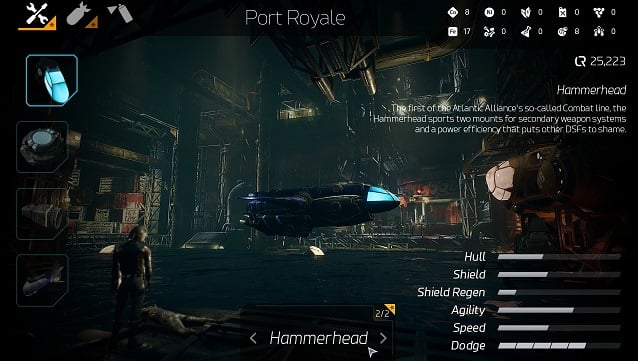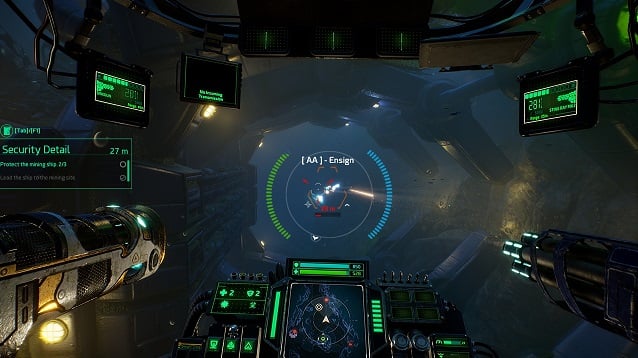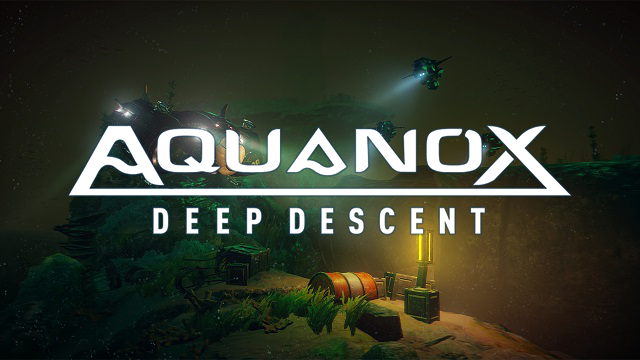It’s been a long time since games like Aquanox and Descent ruled the seas and the voids of space, and while we’re still awaiting the latter to make its triumphant return, the former will soon return to take fans of 6DOF vehicle shooters back to the crushing depth of the ocean.
Aquanox: Deep Descent is a reimagining of the 2001 game of the same name. While I’ve played plenty of Descent and games like it, such as Sublevel Zero, I had never jumped into the Aquanox cockpit until recently, when I was invited to go hands-on with a roughly one-hour preview of Deep Descent.
Things like movement and combat take a little getting used. Still, once you begin to understand how the game’s mechanics work and gain access to other ships and modules, Aquanox: Deep Descent starts to morph into a fun and somewhat addicting first-person combat sim.
To give myself greater context into the Aquanox games, I purchased the 2001 version of Aquanox on Steam after giving Deep Descent a whirl.
Both games take place in an underwater world where humanity has escaped the dead and dying land above. Aqua, though, is full of warring factions and governments, and it plays host to mutated creatures hell-bent on your destruction.
Deep Descent’s narrative isn’t as immediately gripping as the story in 2001’s Aquanox, which ebbs and flows in a dramatic X-Files like presentation, but it is seemingly more focused on a grander social commentary not found in the original — at least in its opening acts.
Voice acting is currently hit or miss, with some characters nailing the appropriate tone of the world, while others are far less polished. Dialog remains lore heavy, but the pacing is still a bit off, something that I hope is addressed by the time the game releases in October.
Unlike 2001’s Aquanox, which focused on a singular protagonist, Deep Descent introduces players to four characters with various backgrounds. They’re presented in a somewhat tone-deaf, hero-shootery way, and don’t seem to have much bearing on the overall story yet.
The game will feature drop-in co op and PvP at launch (though I wasn’t able to test multiplayer here), so it will be interesting to see how these characters play into that and if they bring their own skills to the table.

Where the narrative seems to diverge from the original, movement and combat in Deep Descent remains virtually the same. Each ship has base values for stats ranging from speed to hull strength to agility. Ships can also be outfitted with a retinue of weapons from Gatlin cannons to missile launchers and shrapnel guns.
For some vessels, movement can be clunky and downright irritating, especially for those expecting something clippier like Descent. If the demo I played is indicative of how the final game will begin — which I believe it is based on the narrative and mission structure of the two missions available — I am a bit worried that some players may find it hard to forgive Deep Descent for dropping them into a ship that moves like oil through water.
That’s not helped along by the nature of the game’s initial combat encounters, which can be unforgiving at best, especially if players skip the tutorial or gameplay tips because they want to jump straight into the action. Knowing to lock onto enemies is a complete game-changer, one that makes the game immensely more enjoyable.
It is worth noting that there will be multiple ships in the final product, as well as modules that can be equipped to those ships. Different makes and models, as well as hull and engine attachments, can be swapped out at ports and will surely make significant differences for players looking to customize the game around their playstyle.
One vexing bugbear I do hope receives attention before launch is the dodge mechanic. Since Deep Descent is a 6DOF shooter, you can move forward and back, left and right, and up and down. In combat, where enemy ships can quickly melt your shields and hull, dodging is a critical maneuver.
Darting left and right is simple enough, but the vanilla controls for dodging up and down (double-tapping the spacebar/left CTRL) are also tied to the input for simply moving up and down (holding the spacebar/left CTRL).
Sometimes, the game registers a hold as a tap, sending you flying up or down though you didn’t want to. This can be an instant killer in combat, especially if you get caught in any part of the environment (which will also damage your ship).

There’s sure to be a lot more to talk about when it comes to Aquanox: Deep Descent, including its beautifully rendered but sometimes drab environments, as well as its economy, trading systems, and side quests. But that will have to wait until our final review in the coming weeks.
Overall, I’m hopeful for what Digital Arrow and THQ Nordic are building lives up to the legacy of the games that came before Deep Descent. I have my concerns, especially regarding the game’s initial stages and its difficulty, even on its easiest setting. But it’s hard to judge a game entirely by the first hour or so.
For what it’s worth, I’ve played through the missions four times now, growing to enjoy the game more each time. Despite my initial reservations, that’s got to count for something.
Stay tuned for more on Aquanox: Deep Descent, which will release on October 16 for PC and retail for $29.99.







Published: Sep 24, 2020 07:56 pm